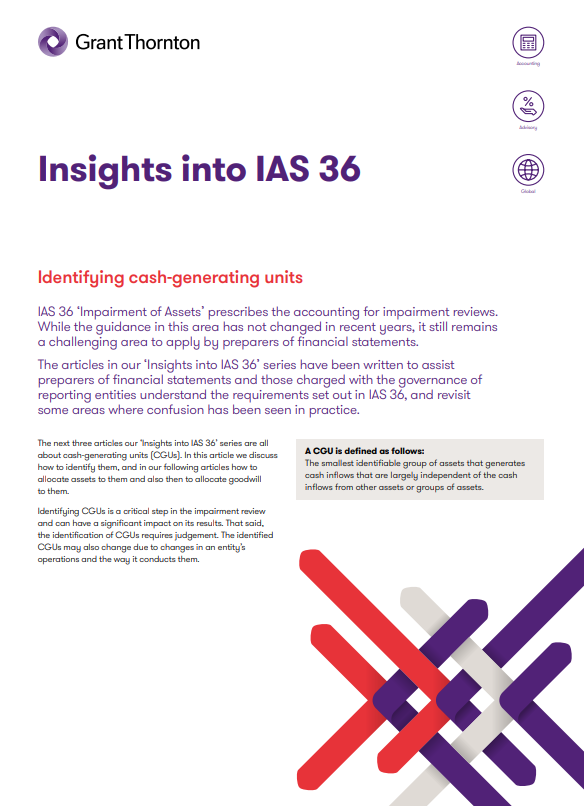-
Corporate Tax
We are your problem solvers for corporate tax issues
-
Restructuring, Mergers & Acquisition
Expertise and creativity for the perfect structure
-
International Tax
We are here, whenever our clients require our assistance
-
Transfer pricing
We are your experts for an optimal transfer pricing structure
-
Indirect Tax & Customs
We take care of your indirect taxes so you can take care of your business
-
Private Wealth
We are your competent partner in the field of Private Wealth Tax Services
-
Real Estate Tax
We are a valuable partner at every stage of your property's life
-
Global Mobility Services
Local roots and global networking as a secret for successful assignment management
-
Advisor for Advisor
As advisors for advisors, we support in complex situations
-
Accounting & Tax Compliance Services
Grant Thornton Austria - Your Partner for Experts for Accounting & Tax Compliance Services. In an evolving regulatory landscape, efficient accounting, tax compliance, and financial statement preparation processes are crucial for maintaining an accurate and up-to-date view of your company’s financial position while ensuring compliance with all legal requirements. We provide tailored solutions that not only save your time and resources but also ensure compliance with complex regulations. Our experts are here to support you, allowing you to focus on your core business.
-
Payroll & People Advisory Services
Ensuring Compliance, Efficiency, and Strategic HR Solutions In an evolving legal landscape, it is crucial for companies of all sizes to have efficient and legally compliant payroll accounting systems. The ever-changing regulations and increasing complexity make this an ongoing challenge. At Grant Thornton Austria, we provide comprehensive, precise payroll processing as part of our Payroll & People Advisory Services. Additionally, we offer customized advisory services to help clients optimise their HR strategy, improve operational efficiency, and minimize potential risks.
-
Tax Controversy Services
Your Partner when it matters most! In increasingly complex environment and considering frequent changes in tax regulations, businesses are facing intensified scrutiny from tax authorities. This has resulted in a significant rise of complex tax audits, investigations and potential disputes. Our Tax Controversy Services are tailored to help you navigate these challenges proactively and effectively. Our experts will guide you through all stages of tax proceedings, ensuring robust defence of your position and advising you on preventive measures to minimize the risk of future tax disputes.
-
Tax Technology Services
Your digital partner for an efficient future! In an increasingly digitalised business world, companies must constantly look for optimisations and adjustments to ensure their long-term success. In order to best prepare for the future and to achieve efficiency increases and process optimisations in the digital area, the experts at Grant Thornton Austria are at your side as a reliable partner as part of our Tax Technology Services.
-
Audit of annual and consolidated financial statements
We place particular emphasis on customized solutions and international service and adapt our services to your needs.
-
Assurance related advisory services
Assurance related advisory services are based on the knowledge and expertise that are the staff of life of our auditors.
-
Global audit technology
We apply our global audit methodology through an integrated set of software tools known as the Voyager suite.
-
Accounting related consulting
Accounting in accordance with UGB, US-GAAP or IFRS is in constant motion. The integration of new regulations into their own accounting systems poses special challenges for companies.
-
Valuation
Valuations are a core competence of Grant Thornton Austria. As auditors and tax advisors we combine profound know-how with our practical experience to offer you customized solutions for your valuation assignment. Our industry expertise is based on years of services to our clients, including listed companies as well as owner-managed companies with an international focus. We advise on valuation matters related to arbitration and provide expert opinions.
-
Forensic Services
When it comes to risks in business, our experts are on hand. We support you not only in suspicious cases or in disputes, but also develop suitable strategies in the area of prevention to avoid serious cases as far as possible. Our Cyber Security team helps you to keep your networks and applications secure and is quickly on hand in the event of a security leak.
-
Cyber Security
Cyber incidents, IT system failures, the resulting business interruptions and the loss of critical data are one of the greatest business risks for companies. Recent cases underline the need for strategic protection and awareness of the issue and require a holistic approach and technical expertise that takes into account all legislative, regulatory and technical aspects of cyber security to protect companies against the daily increase in cybercrime incidents.
-
Sustainability Services
Sustainability is no longer a trend, but the only way to create a future worth living. Our experts will support you in successfully developing your sustainability strategy and preparing your sustainability reporting in compliance with regulations.
-
Transaction Support
We can support you throughout the transaction process – helping achieve the best possible outcome at the point of the transaction and in the longer term.
-
Merger & Acquisition
Companies start new activities and separate from old ones, cooperate and merge. Markets and competitive conditions are subject to constant and increasingly rapid change. As a result, existing business models are changing. Some companies have to restructure and reorganize. But new business opportunities also open up.
-
Restructuring & Going Concern Forecast
Restructuring & Going Concern Forecast: Bundled services for your strategic, operational and financial decisions offer the right answers for companies, banks, shareholders and investors.
-
Internal Audit
Internal Audit helps companies and organisations to achieve their goals by analysing and evaluating the effectiveness of risk management, controls and management and monitoring processes. Internal Audit focuses on independent and objective audit (assurance) and consulting services that improve the value creation and business activities of your company.
-
Expert dispute resolution & advisory
Grant Thornton Austria offers comprehensive services in the field of business-oriented expert services with a broad range of competencies from banking to communication. The core activity of experts is the objective recording of findings and the preparation of expert opinions - regardless of all external circumstances. Our experts Gottwald Kranebitter and Georg H. Jeitler, as sworn and court-certified experts, ensure that the highest professional standards and the principle of objectivity are observed.
-
Blockchain and Crypto-Asset
Blockchain as a carrier technology for crypto currencies and smart contracts, among other things, is becoming increasingly important. Grant Thornton Austria offers comprehensive audit and confirmation services for block chain technologies and business models.
-
International Project Coordination
Our International Engagement Management team is your central point of contact for international projects in all our service lines. We take care of operational project management for you and act as a central point of contact and coordination for your projects. We support companies that start international projects from Austria as well as companies from abroad that want to gain a foothold in Austria or use Austria as a hub for their international projects, especially in the DACH (Germany, Austria and Switzerland) and CEE region.
-
International Desks
As a member of the Grant Thornton network, we guarantee direct access to resources from our worldwide circle of partners. This global connection enables us to seamlessly integrate highly qualified specialists and industry experts from different countries around the world into our teams. Through our broad perspective and diverse expertise, we ensure that we can optimally meet the individual requirements of our clients in an increasingly globalised economy.
In this article we discuss how to identify cash-generating units (CGUs), and in our following articles we cover how to allocate assets to them and also then to allocate goodwill to them.
Identifying CGUs is a critical step in the impairment review and can have a significant impact on its results. That said, the identification of CGUs requires judgement. The identified CGUs may also change due to changes in an entity’s operations and the way it conducts them.
Roles of the cash-generating unit in the impairment review
A CGU serves two primary roles in the impairment review. It facilitates the testing of:
- assets for which the recoverable amount cannot be determined individually, and
- goodwill and corporate assets for impairment.

Goodwill and corporate assets by definition do not generate cash inflows on their own and therefore, must be allocated to a CGU or groups of CGUs for impairment testing purposes. The allocation of goodwill and corporate assets is discussed in our articles ‘Insights into IAS 36 – Allocating assets to cash-generating units’ and ‘Insights into IAS 36 – Allocating goodwill to
cash-generating units’.
Identifying cash-generating units
The objective of identifying CGUs is to identify the smallest identifiable group of assets that generates largely independent cash inflows. CGUs are identified at the lowest level to minimise the possibility that impairments of one asset or group will be masked by a high-performing asset.
To identify a CGU, an entity asks two questions:
- Does a group of assets generate largely independent cash inflows?
- Is there an active market for the output?

Does a group of assets generate independent cash inflows?
Put simply, identifying CGUs involves dividing the entity into clearly identifiable components. Because the CGU definition is based on cash inflows, the division process should focus on an entity’s sources of revenue and how assets are utilised in generating those revenues. Management will need to consider various factors including how it monitors the entity’s operations (such as by product lines, businesses, individual locations, districts or regional areas) or how management makes decisions about continuing or disposing of the entity’s assets and operations.
Practical insightOperational structure over legal structureIt may be the case that the design and management of an entity’s operations does not reflect the legal structure of the group. Depending on the circumstances, a CGU might correspond to a legal entity, a division, product line, geographic region, physical location (such as a hotel or retail store) or collection of assets. |
The following examples illustrate the identification of the lowest aggregation of assets that generate largely independent cash
inflows in different circumstances.
Example 1 - Identifying the CGU: lowest level of largely independent cash inflows
A bus company provides services under contract with a municipality that requires minimum service on each of five separate routes. Assets devoted to each route and the cash flows from each route can be identified separately. One of the routes operates at a significant loss.
Because the entity does not have the option to curtail any of those bus routes, the lowest level of identifiable cash inflows that are largely independent of the cash inflows from other assets or groups of assets is the cash inflows generated by the five routes together. The CGU is the bus company as a whole.
Example 2 - Identifying the CGU: supermarket chain
Entity A owns and operates 10 supermarkets in a major city (City B), each store residing in a different suburb throughout City B. Each supermarket in City B purchases its inventory through Entity A’s purchasing centre. Pricing, marketing, advertising and human resources policies (except for the hiring of each supermarket’s local staff) are decided by Entity A. Entity A also operates 50 other supermarkets in other major cities across the country.
The supermarkets in City B probably have different customer bases as they reside in different suburbs. Accordingly, although operations are managed at a corporate level by Entity A, each supermarket generates cash inflows that are largely independent of those of other supermarkets. Therefore, it is likely each supermarket in City B is a separate CGU.
In making its judgement about whether each supermarket is a separate CGU, Entity A might also consider if:
- management reporting monitors revenues on a supermarket-by-supermarket basis in City B, and
- how management makes decisions about continuing or closing its supermarkets (eg on a store-by-store or on a region/city basis).
The IFRS Interpretations Committee (IFRIC) was asked to develop an Interpretation on whether a CGU could combine more than one individual store location. The submitter developed possible considerations including shared infrastructures, marketing and pricing policies, and human resources. The IFRIC noted IAS 36 requires identification of CGUs on the basis of independent cash inflows rather than independent net cash flows and so outflows such as shared infrastructure and marketing costs are not considered. In its March 2007 agenda decision, the IFRIC took the view developing guidance beyond that already given in IAS 36 on whether cash inflows are largely independent would be more in the nature of application guidance and therefore decided not to take this item onto its agenda.
Is there an active market for the output?
When management has identified a group of assets that generate an output, but those assets do not generate largely independent cash inflows, it needs to consider if there is an active market for the output.
For the purposes of applying IAS 36, even if part or all of the output produced by an asset (or a group of assets) is used by other units of the entity (ie products at an intermediate stage of a production process), this asset (or group of assets) represents a CGU if the entity could sell the output on an active market. This is because the asset (or group of assets) could generate cash inflows that would be largely independent of the cash inflows from other assets (or groups of assets).
Practical insightVertically integrated businesses and an active market for outputThis is a common issue for vertically integrated businesses whereby some groups of assets do not generate independent cash inflows, only because each operation’s output is used internally, rather than being sold externally. IAS 36 addresses this issue by clarifying that even if part or all of the output produced by an asset (or a group of assets) is used by other units of the entity, this asset (or group of assets) forms a separate CGU if the entity could sell the output on an active market. An active market is defined in IFRS 13 ‘Fair Value Measurement’ as ‘a market in which transactions for the asset or liability take place with sufficient frequency and volume to provide pricing information on an ongoing basis’. This may be the case for certain commodities such as oil or gold. |
Example 3 - Identifying the CGU: active market for the output
Entity X produces a single product (widgets) and owns production plants 1, 2 and 3. Each plant is located in a different region of the world. Plant 1 produces a component of the widgets that is assembled in either plant 2 or plant 3 and sold worldwide from either plant 2 or plant 3. Neither plant 2 nor plant 3 is operating at full capacity.
The utilisation levels depend on the allocation of order fulfillment between the two locations of order fulfillment between the two locations.
Scenario 1: There is an active market for plant 1’s component.
Scenario 2: There is no active market for plant 1’s component.
Scenario 1: It is likely plant 1 is a separate CGU because there is an active market for its output. As cash inflows for plants 2 and 3 depend on the allocation of production across the two locations, it is unlikely the future cash inflows for plants 2 and 3 can be determined individually so they would probably be combined into a single CGU.
In determining the VIU of plants 1, 2 and 3, Entity X will adjust its financial budgets/forecasts to reflect its best estimate of future prices that could be achieved in arm’s length transactions for plant 1’s output while also incorporating future cash outflows used to determine the VIU of other assets impacted by the internal transfer pricing.
Scenario 2: It is likely the three plants (1, 2 and 3) are a single CGU because:
- there is no active market for plant 1’s output and its cash inflows depend on sales of the final product by plants 2 and 3
- cash inflows for plants 2 and 3 depend on the allocation of production across the two locations. It is unlikely the future cash inflows for plants 2 and 3 can be determined individually.
Where the cash inflows generated by an asset or CGU are affected by internal transfer pricing, an entity uses management’s best estimate of future prices that could be achieved in an arm’s length transaction in estimating:
- the future cash inflows used to determine the asset’s or CGU’s value in use (VIU), and
- the future cash outflows used to determine the VIU of any other assets or CGUs that are affected by the internal transfer pricing.
When the group of assets does not generate cash inflows that are largely independent and there is no active market for its output (even if used internally), the group is not a CGU. Management then has to combine these assets with others that contribute to the same revenue stream until a CGU is identified.
Changes in identified cash-generating units
Unless a change is justified, CGUs are identified consistently from period to period for the same asset or types of assets. If a change in CGUs is justified (eg an asset belongs to a different CGU than in previous periods or previously recognised CGUs are combined or subdivided), and an impairment loss is recognised or reversed for the CGU, the entity should disclose additional information.
Practical insightTriggers for a change in CGU structureIAS 36 does not provide examples of events or circumstances that would justify a change in CGUs. Such a change would generally be appropriate only if there has been a change in the entity’s operations – ie different revenue-generating activities or different utilisation of assets in undertaking those activities. Typical triggers for a change might include:
|
Practical insightA change in CGU structure over timeThe factors that justify a change in CGU structure sometimes develop over time rather than being driven by a specific event. For example, an entity might gradually change the way it allocates order intake across its production facilities or how it utilises assets to generate a revenue stream. In our view, the change in CGU structure is justified if an asset’s cash inflows become, or cease to be, independent even if this cannot be attributed to a specific event. One practical suggestion for determining the effective date of the change is to consider when management began reviewing or assessing the CGUs differently (eg when management reporting changed). |
How we can help
We hope you find the information in this article helpful in giving you some insight into IAS 36. If you would like to discuss any of the points raised, please speak to our experts Christoph Zimmel and Rita Gugl.



